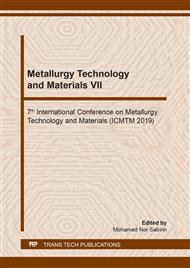p.38
p.43
p.52
p.59
p.64
p.69
p.75
p.83
p.89
Design and Verification of a Metal 3D Printing Device Based on Contact Resistance Heating
Abstract:
As a branch of 3D printing technology, metal 3D printing is an important advanced manufacturing processing method. Metal 3D printing technology has been widely applied in a variety of areas, including the aerospace field, biomedical research and mold manufacturing. This paper proposed a new method for melting metal wires via contact resistance heating. Through the combination of a numerical control technique, a mechanical structure and computer software, a metal 3D printing device was designed based on the principle of fused deposition modeling. The printing nozzle of the device can be heated to over 1400°C in a few minutes. Additionally, we performed experiments with aluminum wire to demonstrate the feasibility of the printing method. The designed consumer-level desktop metal 3D printer cost less than 1500 dollars to fabricate.
Info:
Periodical:
Pages:
64-68
Citation:
Online since:
October 2019
Authors:
Price:
Сopyright:
© 2019 Trans Tech Publications Ltd. All Rights Reserved
Share:
Citation:


